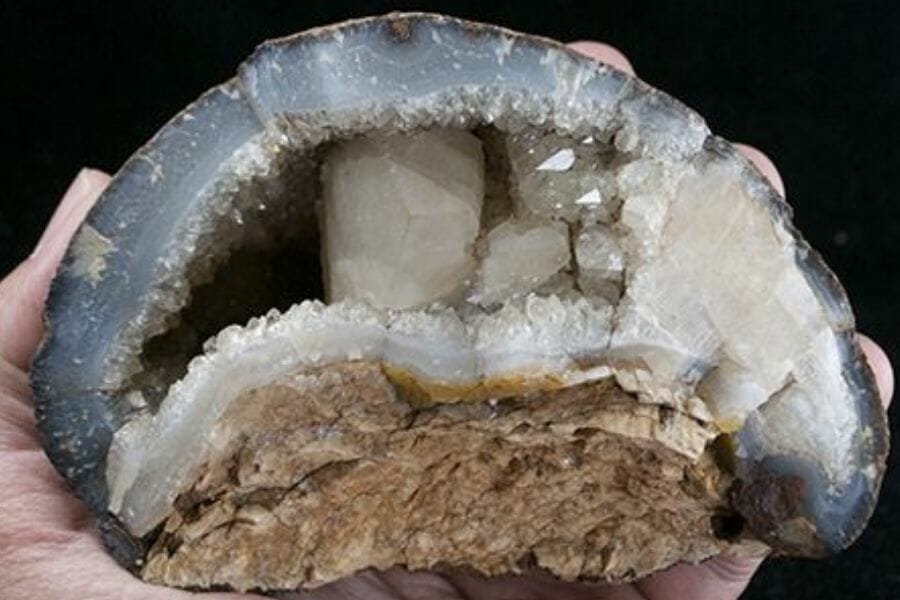Geodes are like nature’s surprise eggs, filled with sparkling crystals inside a plain-looking rock. Our state is a treasure trove for these hidden gems, with its many different landscapes that make it perfect for rock hounds.
If you’re itching to crack open your own crystal-filled wonder, you’re in the right place!
This article will show you the best spots in our state to find geodes. We’ll also share some handy tips to make your geode hunting adventure a success.
So grab your hammer and get ready to discover the beauty hiding in ordinary-looking rocks all around this state!
How Geodes From Here
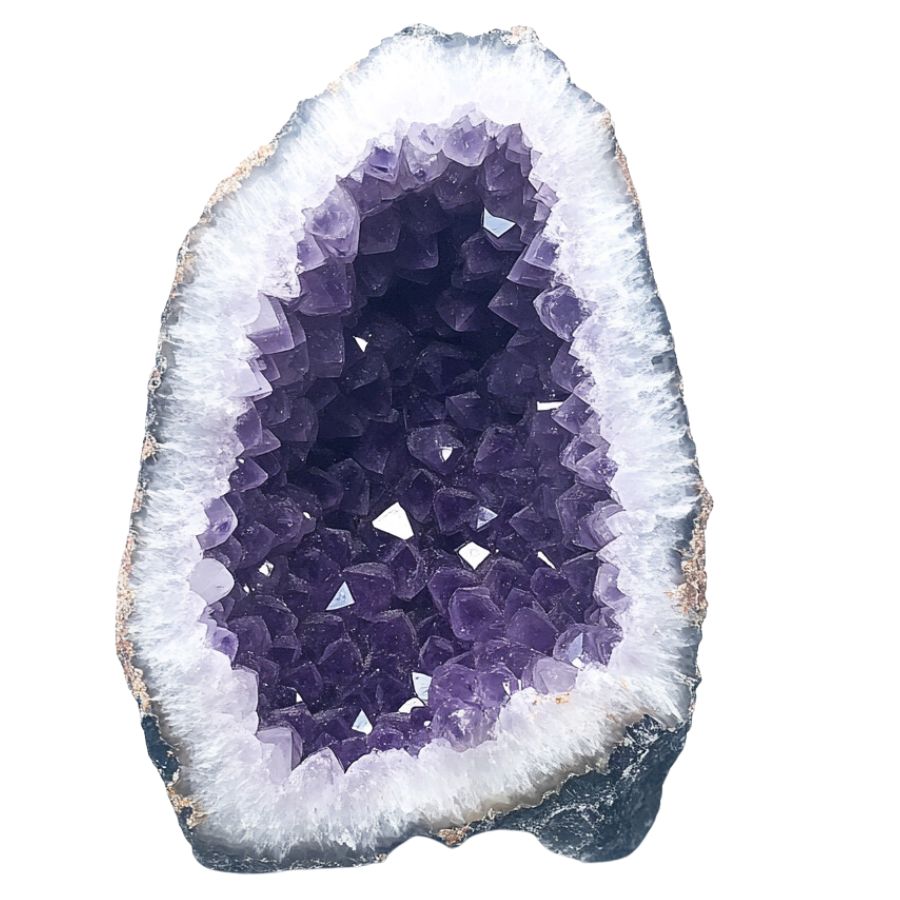
Geodes form when bubbles in volcanic rocks or spaces in sedimentary rocks get filled with minerals over time.
First, water rich in minerals like quartz or calcite seeps into the hollow space. As the water evaporates, it leaves behind the minerals, which slowly build up layer by layer.
Eventually, these minerals create a crystal lining inside the geode. The outer shell stays rough, while the inside becomes a sparkling treasure.
The process can take thousands, even millions, of years, making each geode a unique and beautiful time capsule of Earth’s natural forces.
The Types Of Geodes Found in the US
There are many fascinating varieties of geodes that can be found across the United States, including in our own state. Each type is distinctly beautiful and intriguing:
Amethyst Geode
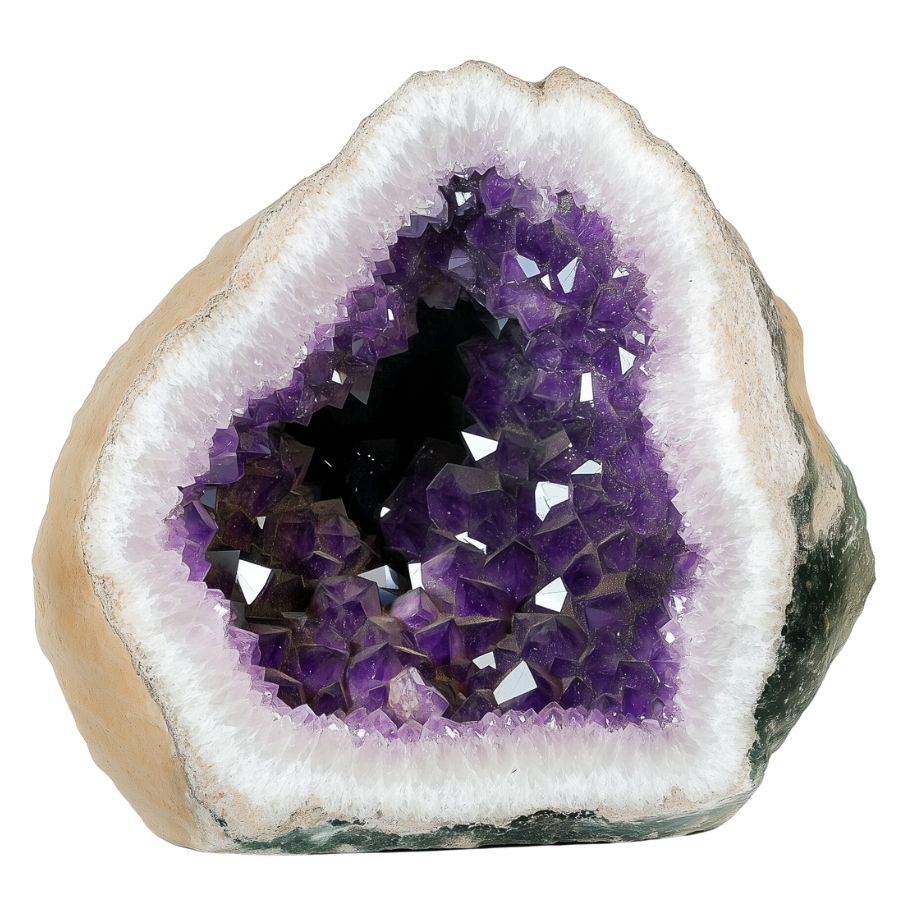
Amethyst geodes look plain on the outside, like a potato. But crack them open, and you’ll find stunning purple crystals. These crystals can be light lavender or deep purple.
The structure of crystals inside can vary widely. Some are tiny and densely packed, creating a sparkling surface. Others form large, distinct points that jut inwards.
The color range is impressive too, from pale lilac to deep royal purple. Some amethyst geodes develop unique features. “Stalactites” of amethyst might hang from the top.
In rare cases, you might find a water bubble trapped inside, a remnant from the geode’s formation millions of years ago.
Citrine Geode
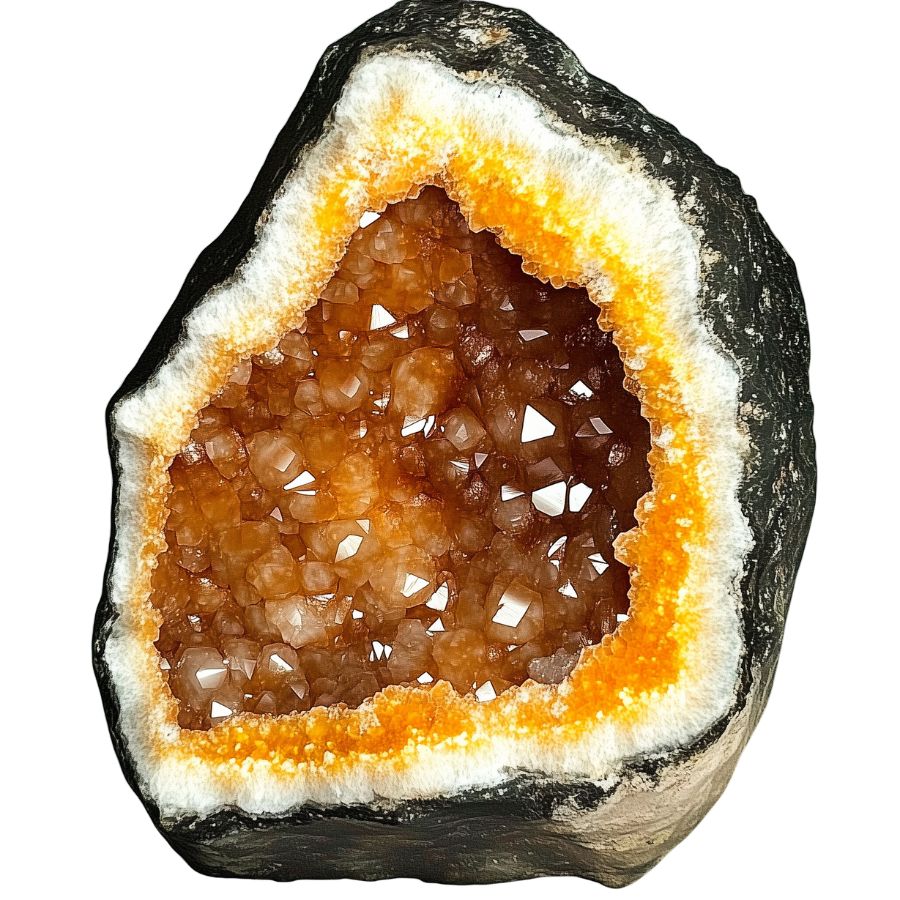
Citrine geodes are eye-catching rocks with golden yellow to orange crystals inside. They sparkle when light hits them, looking like sunshine trapped in stone. The colors come from iron mixed in with the quartz.
Unlike many gemstones, citrine’s color is often evenly distributed throughout the crystal.
Most citrine on the market isn’t natural. It’s actually heat-treated amethyst. This process turns the purple amethyst into vibrant citrine. Natural citrine is rarer and often has a more subtle color.
Pyrite Geode
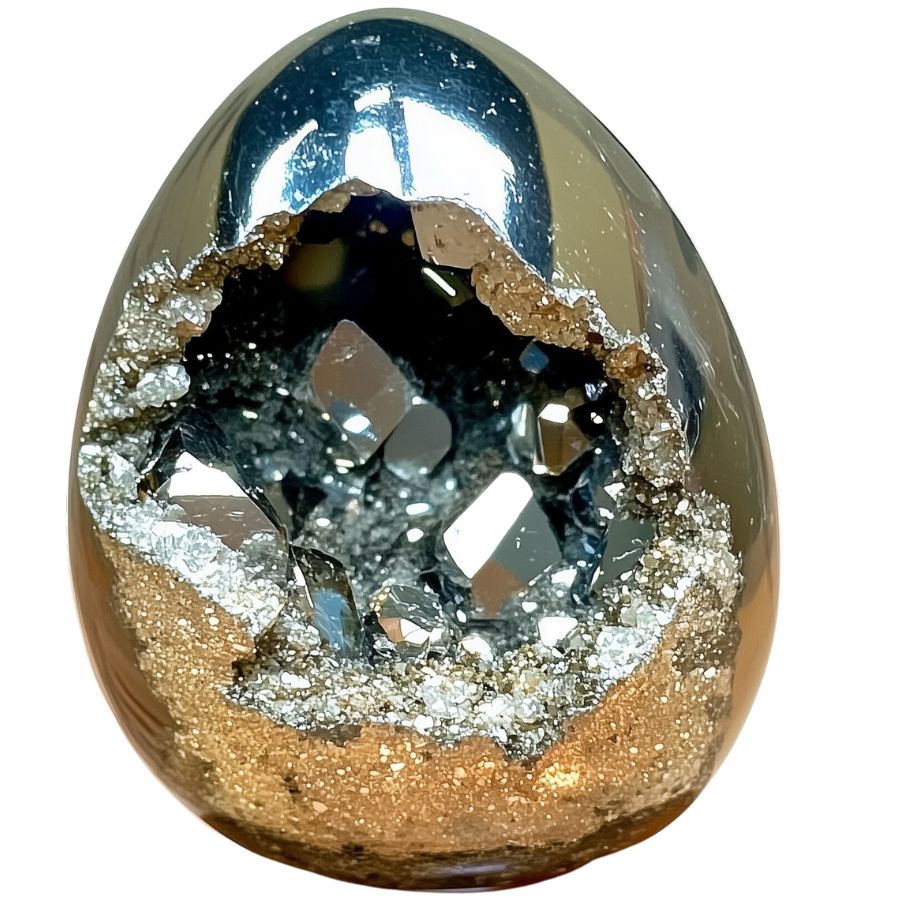
Ever cracked open a rock and found gold inside? Well, not real gold, but something that looks just like it. That’s a pyrite geode. Pyrite is called “fool’s gold” because it’s so shiny and golden.
Inside these geodes, pyrite forms in cool shapes. Sometimes it’s perfect cubes. Other times its clumps or even round balls called “pyrite suns”.
Pyrite has a fun history. People have been mixing it up with real gold for thousands of years. That’s how it got its nickname.
Selenite Geode
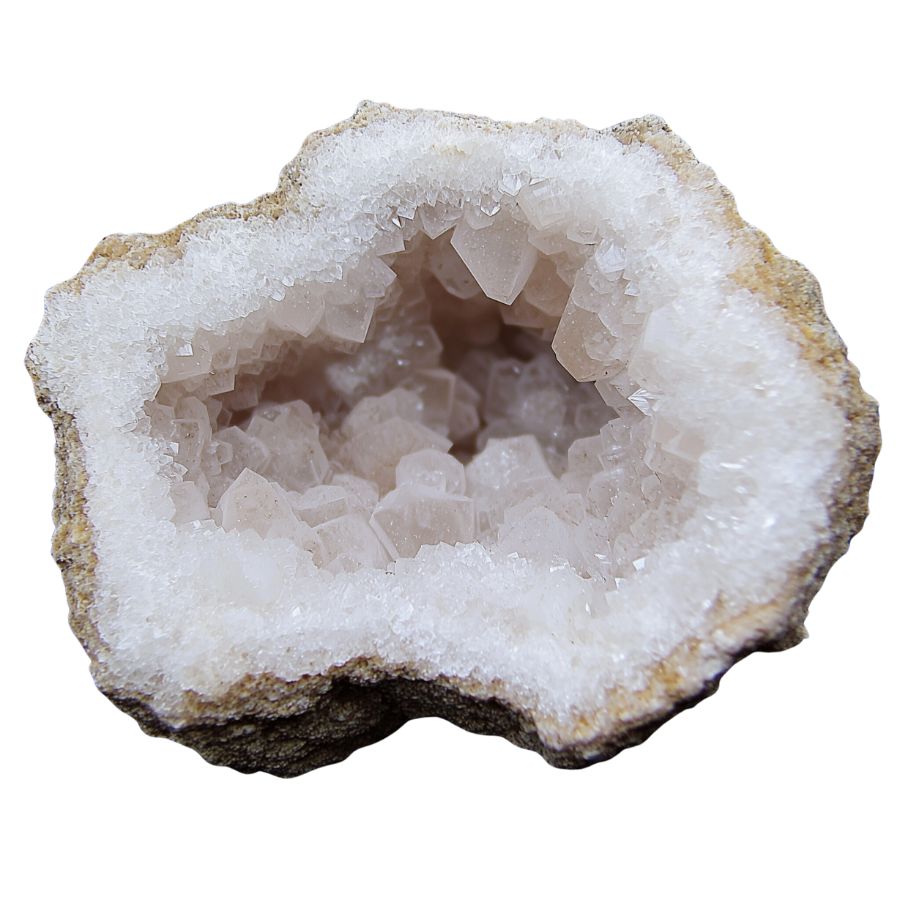
Selenite geodes stand out from the crowd. They’re white and see-through, with a glassy look. When you open one up, you’ll see crystals that look like they’re made of ice or moonlight.
Unlike harder geodes, selenite is soft. You can scratch it with your fingernail! This softness means you need to handle it carefully. But it also means selenite can be shaped into beautiful forms easily.
One cool thing about selenite is how it plays with light. Hold it up to a lamp, and you’ll see the light shine right through it. This makes selenite geodes popular for decorative lamps and light fixtures. They add a magical glow to any room.
Celestite Geode
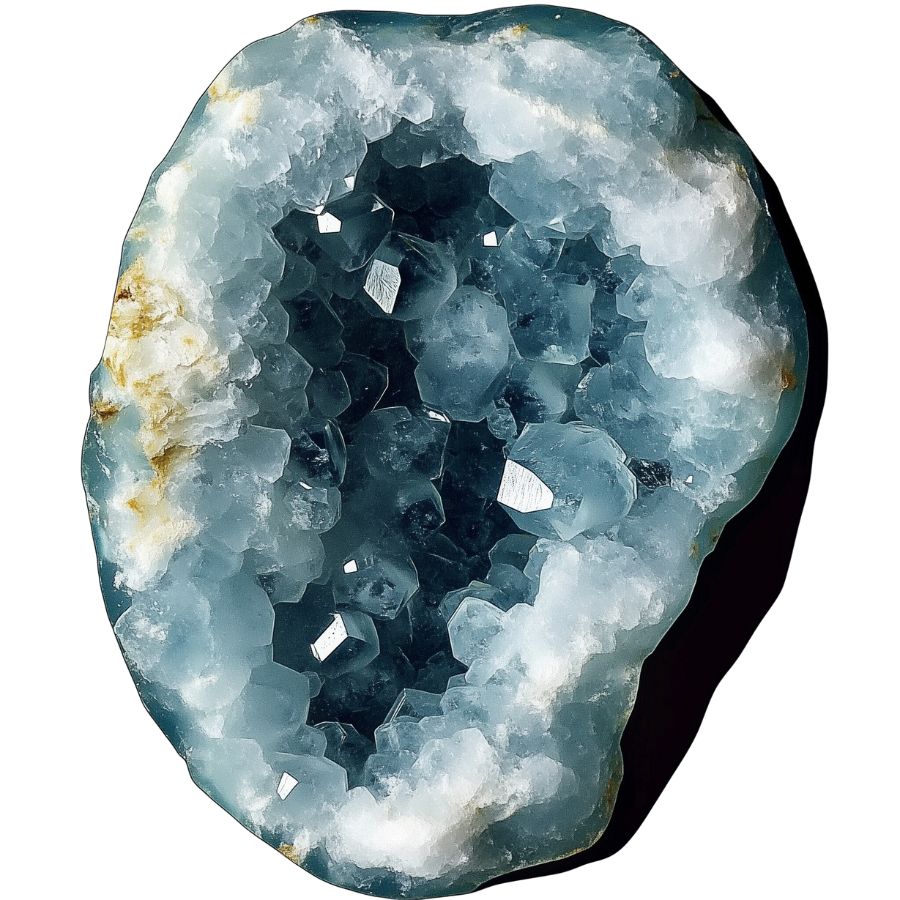
Celestite geodes are like pieces of sky trapped in rock. Their crystals are typically a delicate blue, ranging from almost colorless to deep sky blue. In rare cases, celestite can form in other colors. Pink celestite is highly prized by collectors.
One unique feature of celestite is its perfect cleavage. This means the crystals can be easily split into rhombohedral shapes.
These geodes form in a unique way. They start as nodules of a soft mineral called alabaster. Over time, this dissolves and is replaced by celestite crystals. Some celestite geodes are huge, like the famous Crystal Cave in Ohio.
Celestite isn’t just pretty to look at. It’s used to make strontium, an element with many uses. You’ll find strontium in fireworks, where it creates red colors. It’s also used in making TV screens and ceramics.
Jasper Geode
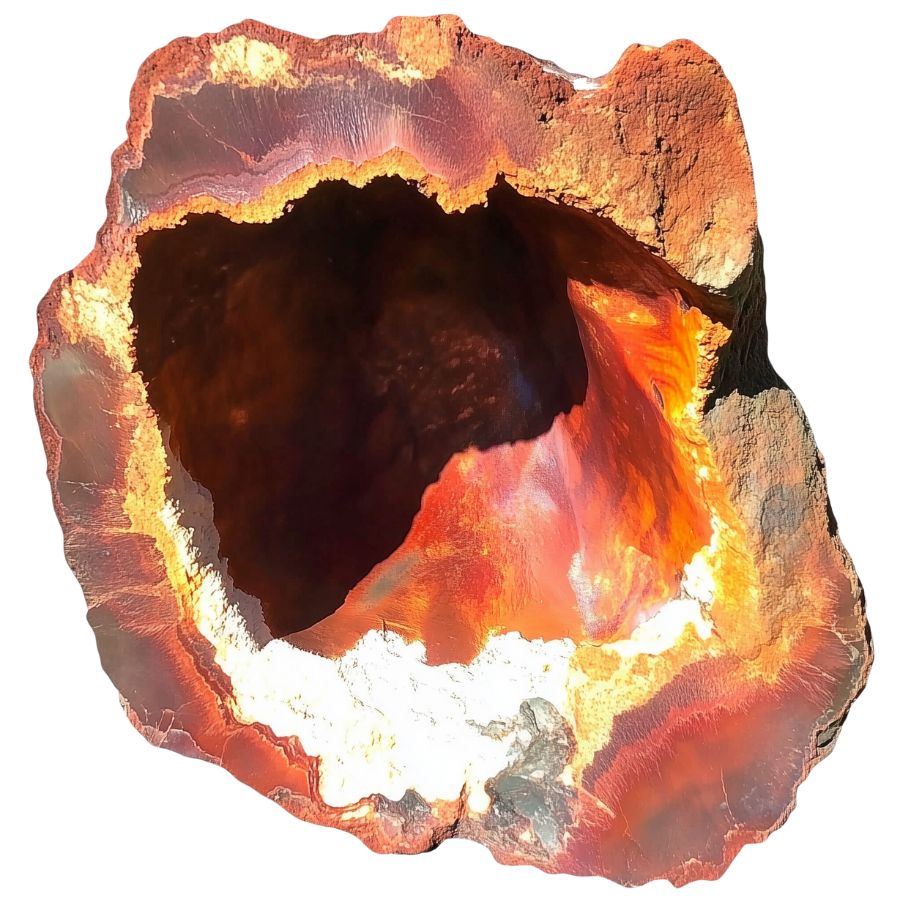
Jasper geodes are the chameleons of the mineral world. They can appear in almost any color, often with multiple hues in a single specimen. Patterns can range from solid colors to intricate swirls, bands, or spots.
One fascinating type is picture jasper. These geodes contain patterns that resemble landscapes, with “skies,” “mountains,” and “rivers” visible in the stone. Each one is like a miniature painting created by nature.
Some jasper geodes contain orbicular patterns – spherical structures that formed as the jasper solidified. These create eye-catching bull’s-eye or flower-like designs in the stone, making each piece truly one-of-a-kind.
Carnelian Geode
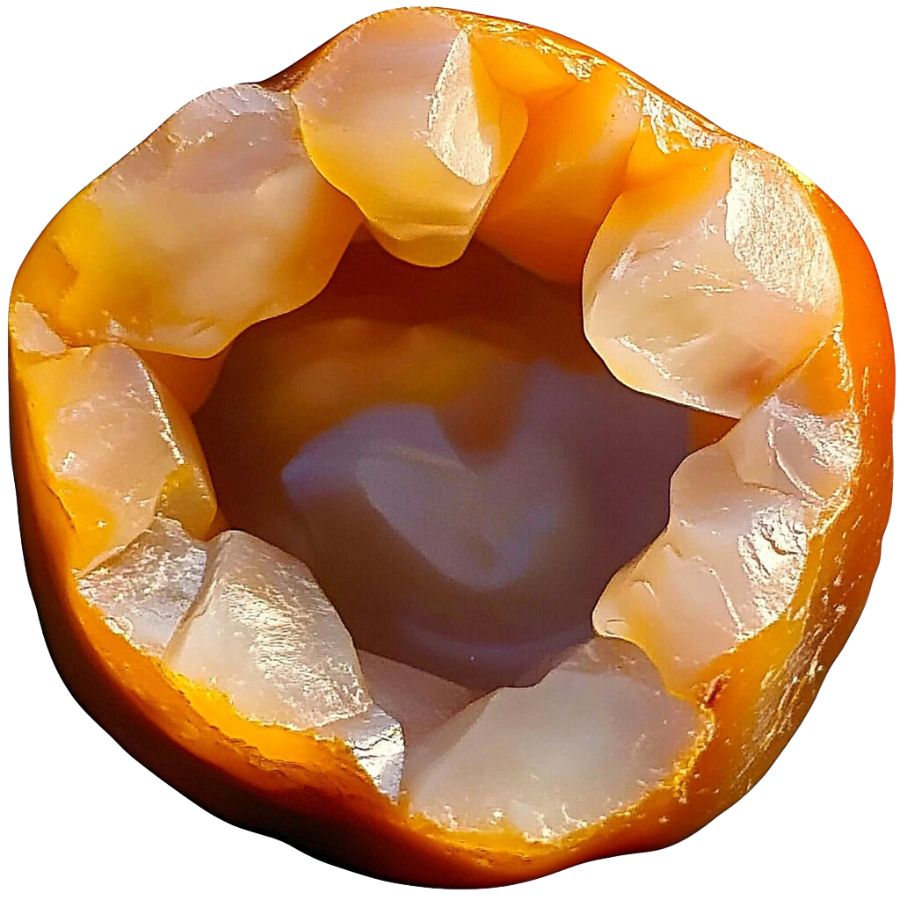
Carnelian geodes have vibrant orange to reddish-brown colors. They can be somewhat see-through, which makes them look even more interesting. The bright colors come from the iron in the stone.
These geodes stand out from other similar stones. They’re brighter than sard, which is usually darker and more brownish. And unlike agate, carnelian doesn’t have bands or stripes.
Carnelian has been popular for a long time. Ancient Egyptians and Greeks used it to make special rings. It’s tough enough for everyday jewelry.
Some people heat or dye carnelian to make its color even brighter. This makes it a favorite for both rock collectors and jewelry lovers.
Fluorite Geode
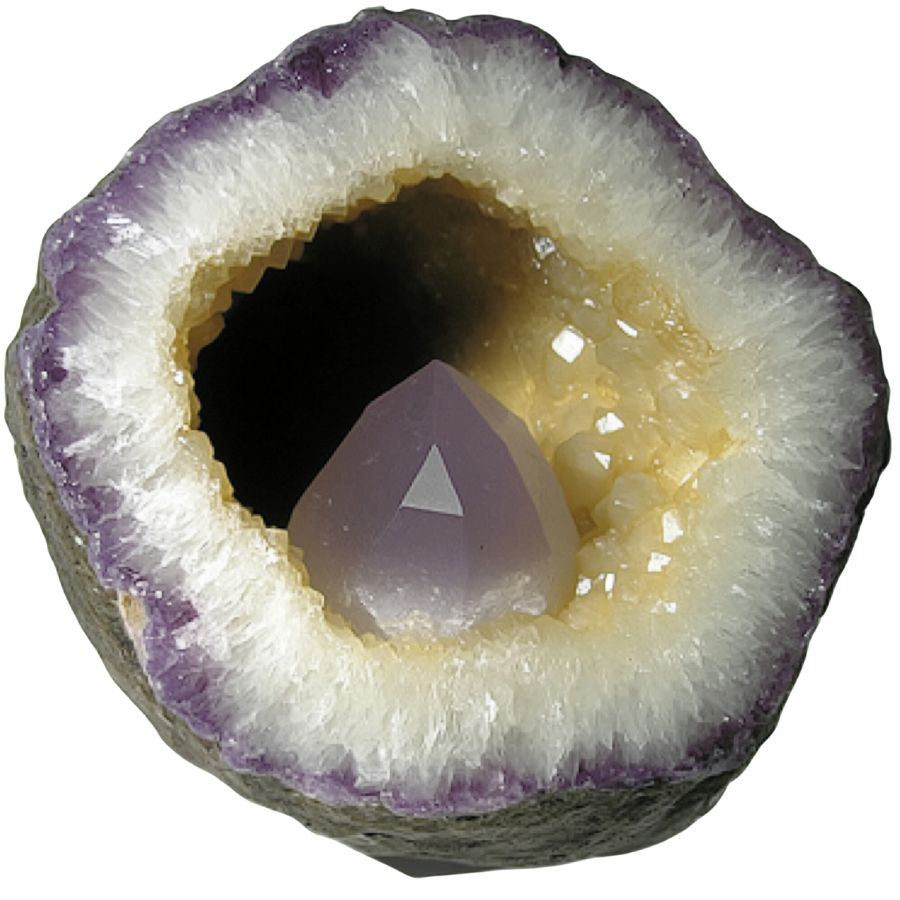
Fluorite geodes are like nature’s rainbow. They come in many colors – purple, green, blue, yellow, and sometimes even clear or black. When you open one up, you might see cube-shaped or eight-sided crystals inside.
What makes fluorite special is that you can often see more than one color in a single stone. This is different from many other geodes. Also, fluorite has a unique way of splitting when it breaks.
A cool fact: fluorite glows blue under ultraviolet light. This was first discovered back in 1852. Because of its many colors and this glowing ability, fluorite is sometimes called the “most colorful mineral in the world.”
Scolecite Geode
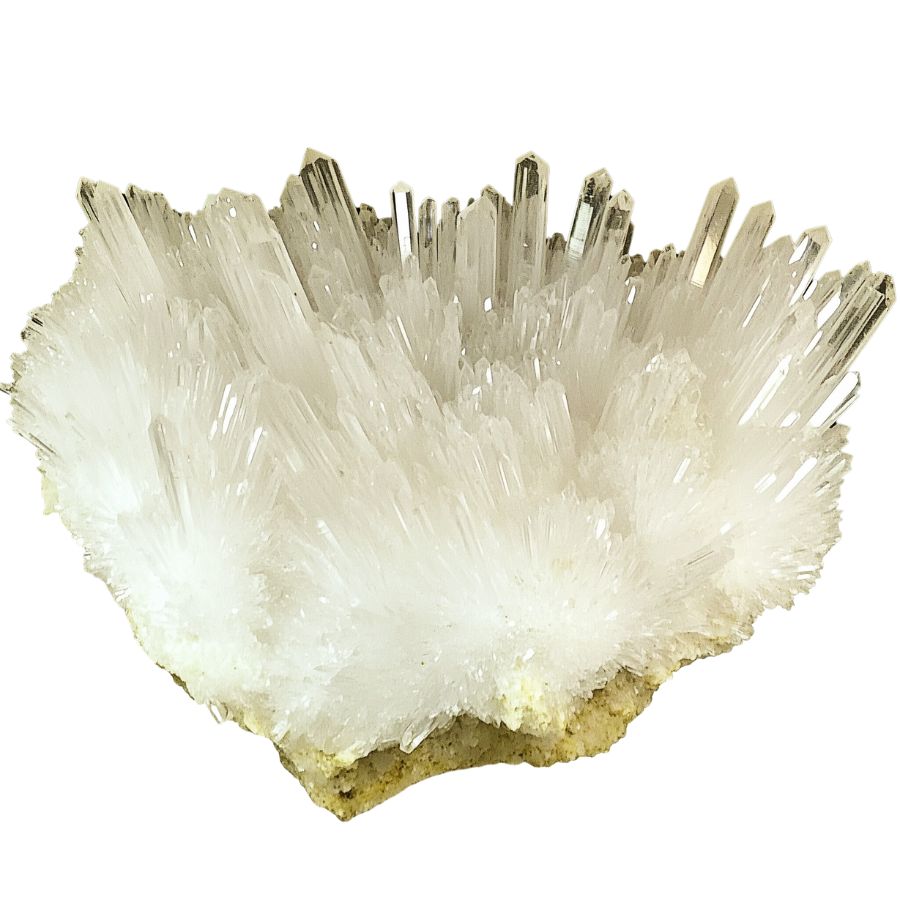
Scolecite geodes are like tiny crystal caves. They’re usually white or colorless, but sometimes you might find pink, yellow, or green ones.
What makes them special is the crystals inside. They look like thin needles or delicate hairs, all pointing out from the center.
These geodes are different from others because of their crystal shape. Instead of blocky or chunky crystals, scolecite has these fine, hair-like ones. This gives them a unique, delicate look.
Scolecite has an interesting property – it can hold a lot of water in its structure. This means it can absorb and release water easily. This makes scolecite useful in various ways, not just as a pretty rock to look at.
Apophyllite Geode
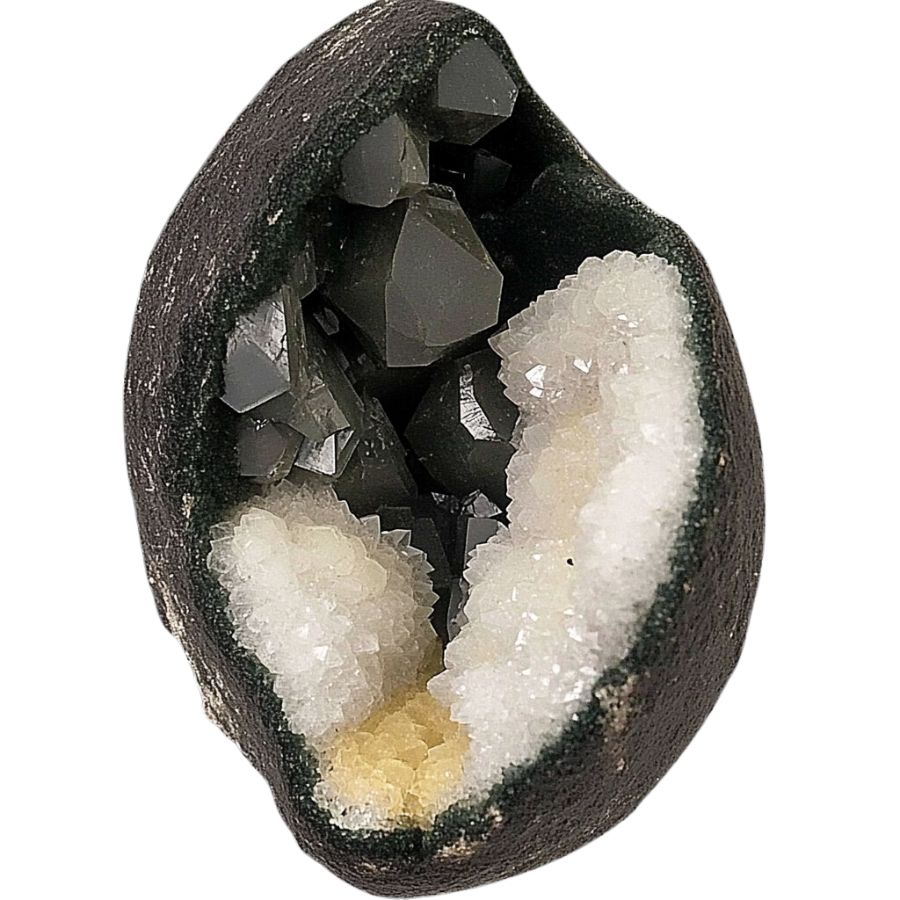
Apophyllite geodes are like nature’s disco balls. They often have dark or black crystals inside a hollow rock. These crystals can be see-through or slightly cloudy, with cube-like or flat shapes.
What makes apophyllite geodes stand out is how the crystals form. They grow in round clusters that look like tiny disco balls. This unique formation is rare and makes them special to rock enthusiasts.
Collectors really prize these “disco ball” clusters. They’re not common, which makes them valuable to people who love unusual rocks. The way apophyllite crystals catch and reflect light adds to their appeal, making them fascinating to look at and study.
What Rough Geode Looks Like
Identifying a rough geode might seem tricky, but with a few tips, you can spot one even if you’re not a rock expert. Here’s how you can do it.
Look for a Rounded Shape
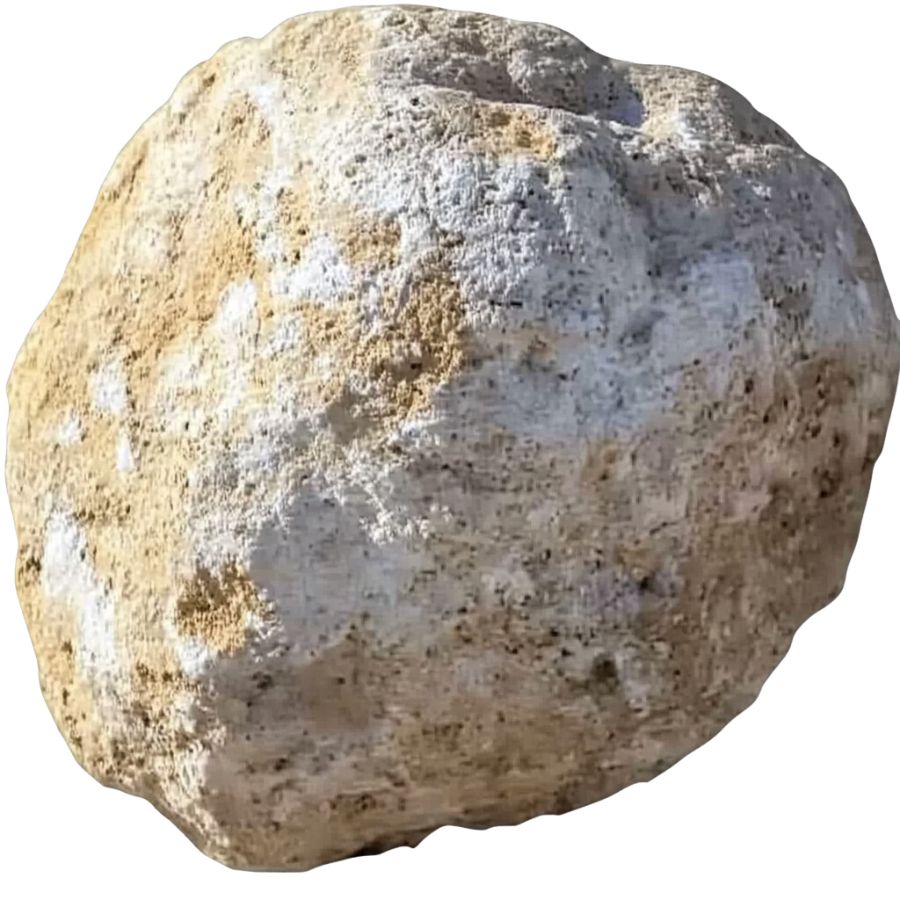
A rough geode often has a rounded or egg-like shape. It might not be perfectly round but look for a generally bulbous form.
When you’re out searching, skip the flat, jagged rocks. Geodes usually have smoother exteriors because they’ve been rolling around in rivers or other environments for a long time.
Check for a Dull, Bumpy Surface
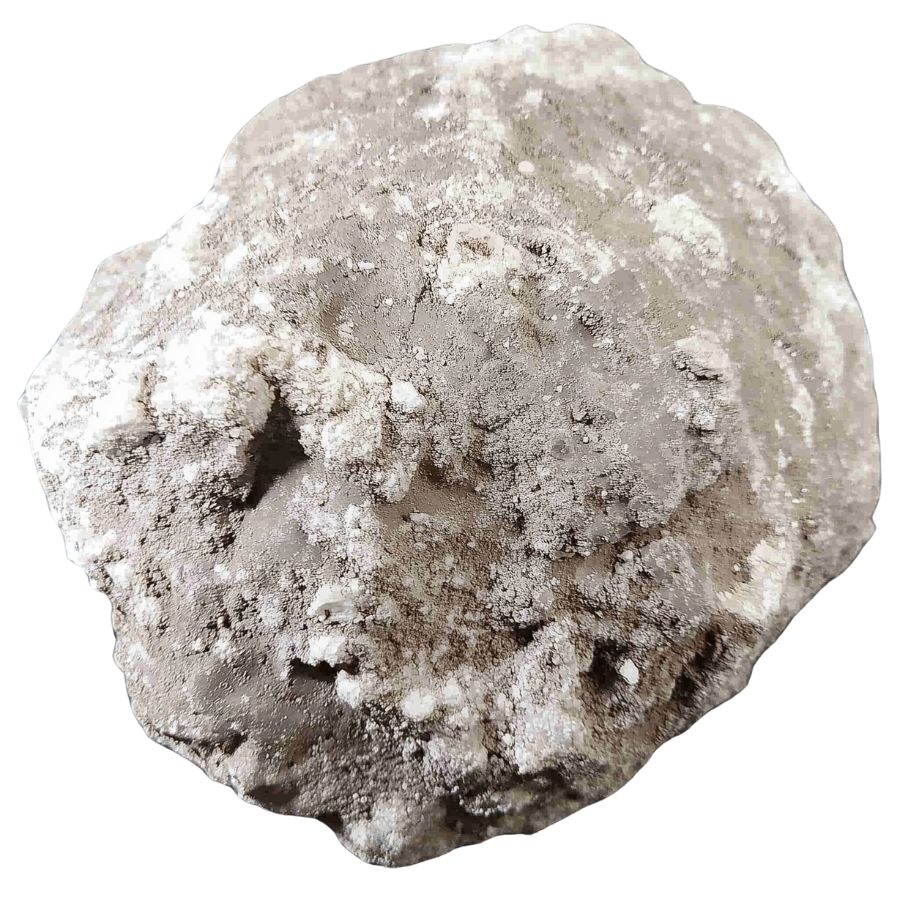
The outside of a geode isn’t usually shiny. Instead, it’s dull, bumpy, and a bit rough.
Imagine a potato or a clump of dirt with some bumps and dents. That’s how a geode might look before it’s cracked open.
The outside won’t give away much of what’s inside, so don’t be fooled by its ordinary appearance.
Test the Weight
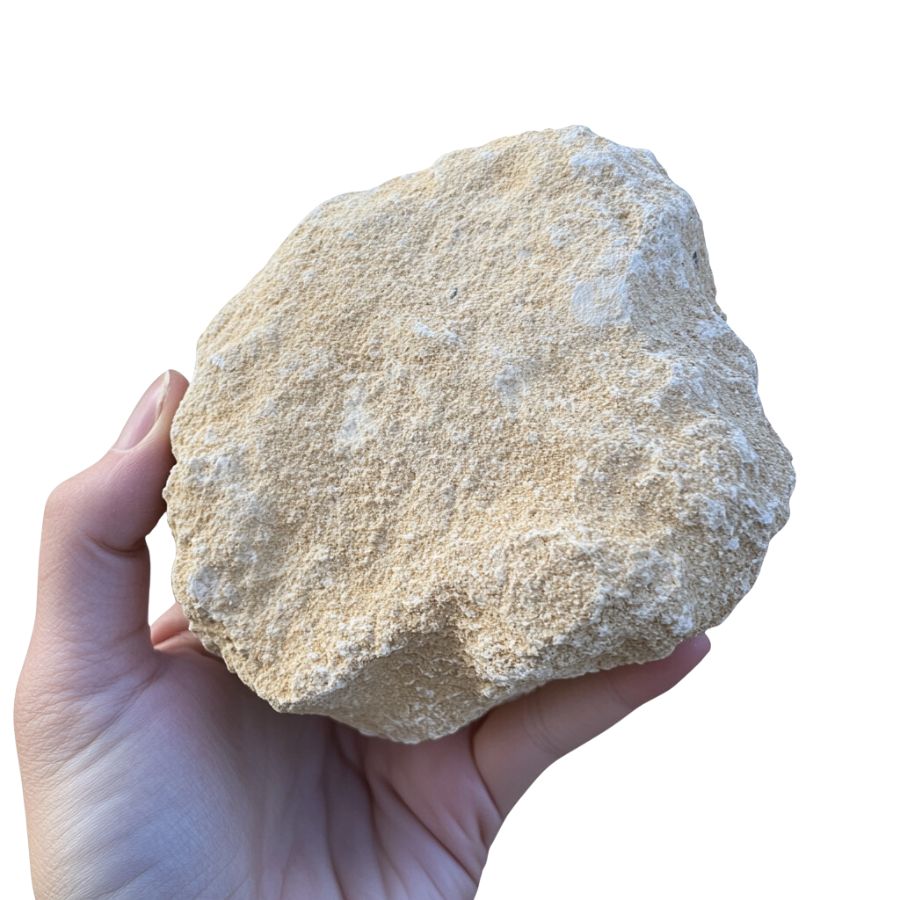
Pick up the rock. Does it feel lighter than it looks? That’s a good sign!
Geodes are hollow or partially hollow, which makes them lighter than solid rocks of the same size. If it feels unexpectedly light, you might have found something special.
Look for Tiny Crystals or Mineral Patches
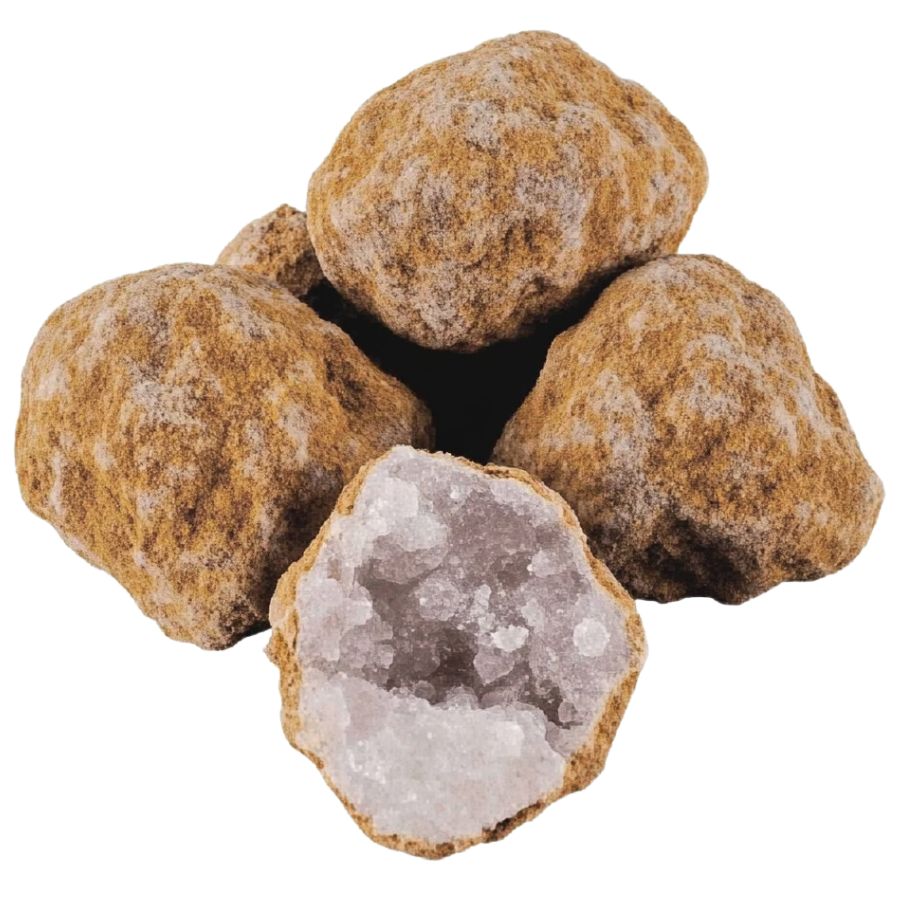
Sometimes, you can spot small crystals or mineral deposits on the outside. These could look like tiny sparkles or specks of color.
While the outside of a geode is usually dull, a little peek of what’s inside might show through. Keep an eye out for these hints, especially if you’re in a known geode-rich area.
Tips on Where to Look
Once you get to the places we have listed below there are some things you should keep in mind when you’re searching:
Explore Riverbeds and Streams
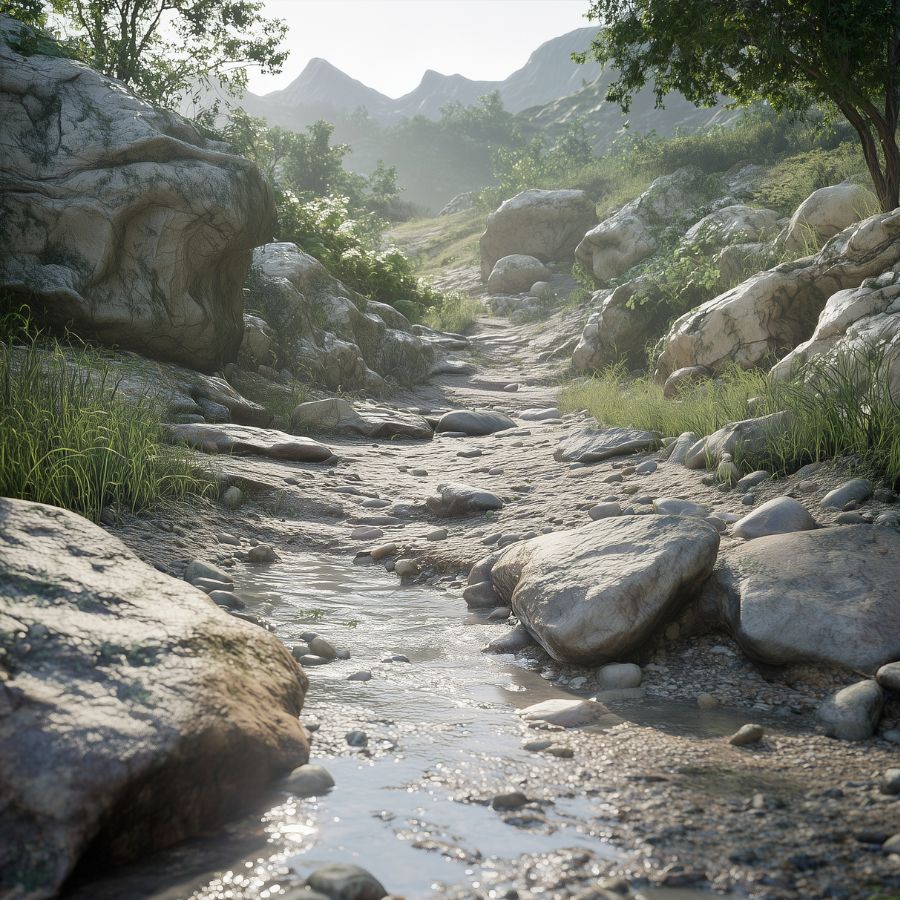
Geodes often form in riverbeds or streams. Water flow smooths out their rough edges and deposits them in these areas.
When exploring, focus on gravel bars or the edges of rivers where rocks naturally gather.
Search in Sedimentary Rock Layers
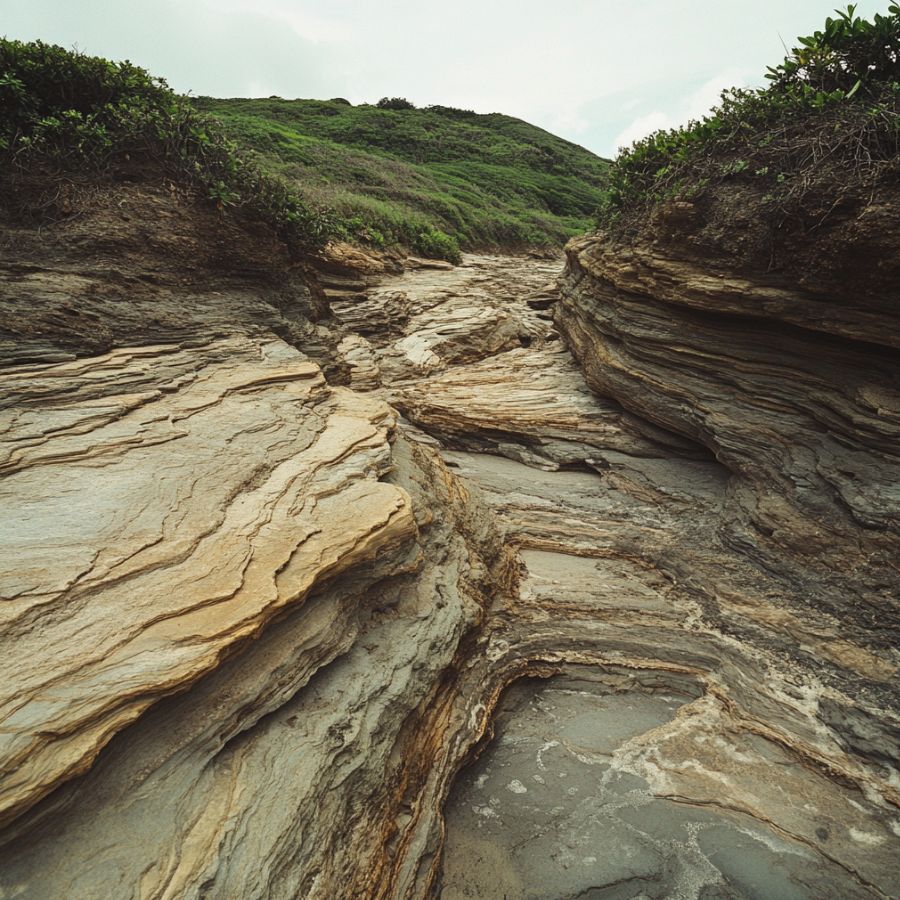
Sedimentary rocks, like limestone, are prime spots for geodes. These rocks form in layers over time, trapping minerals inside.
Look for areas where sedimentary rocks are exposed, such as cliffs or road cuts.
Visit Old Mines or Quarries
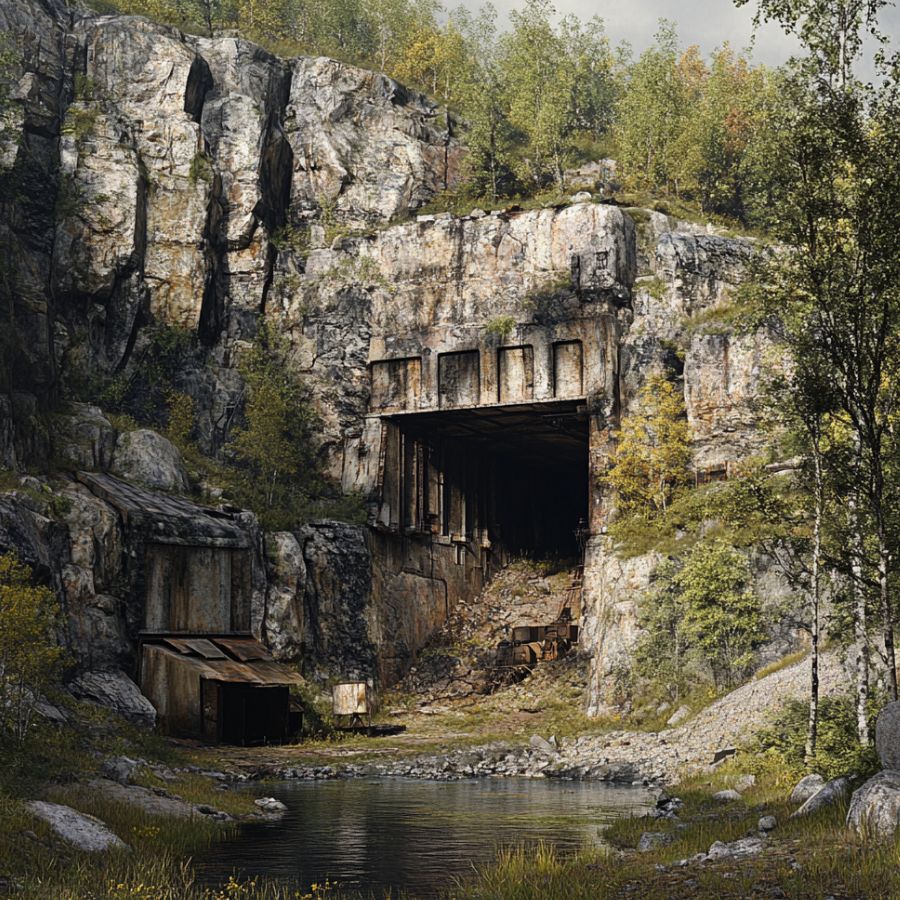
Abandoned mines and quarries are excellent spots for geode hunting.
Workers often missed geodes while digging for other materials. Explore the tailings or leftover rock piles for hidden treasures.
Explore Hills and Rock Outcrops
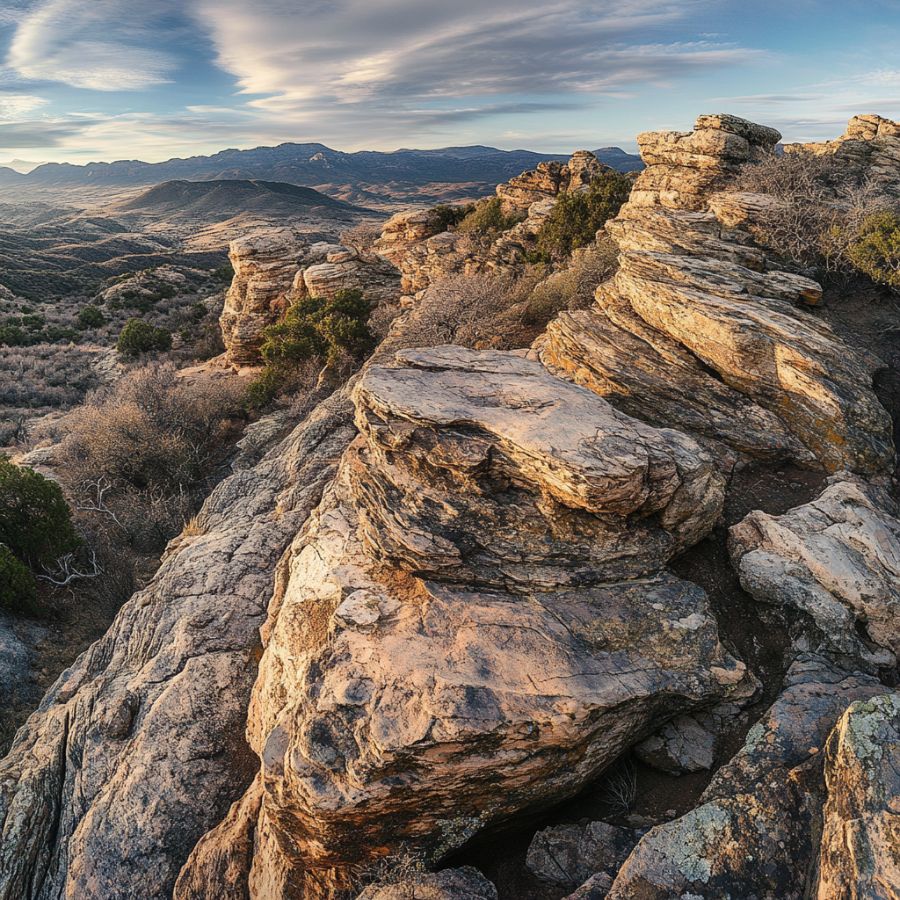
Hills and rocky outcrops often reveal geodes. As erosion wears away the softer rock, it exposes the harder geodes.
Look for areas with exposed rocks and keep an eye out for rounded shapes.
The Best Places To Find Geodes in Alaska
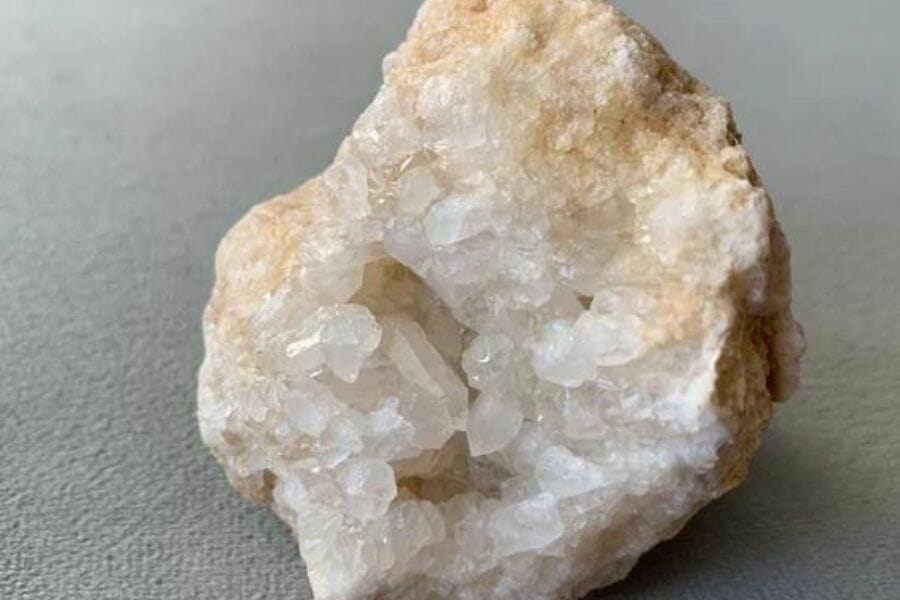
Even if you are conscious of the finest places to mine for gems in Alaska, it can be very difficult to find geodes in their natural environment. It’s reasonable to say that finding geodes in Alaska has been dificult for you. The state has fewer geodes than other states, which explains this. There are no known places where you would have a high chance of finding one because of how uncommon they are.
Alternatively, we can advise you on where in the state to search for rock formations that resemble geodes.
Always Confirm Access and Collection Rules!
Before heading out to any of the locations on our list you need to confirm access requirements and collection rules for both public and private locations directly with the location. We haven’t personally verified every location and the access requirements and collection rules often change without notice.
Many of the locations we mention will not allow collecting but are still great places for those who love to find beautiful rocks and minerals in the wild without keeping them. We also can’t guarantee you will find anything in these locations since they are constantly changing.
Always get updated information directly from the source ahead of time to ensure responsible rockhounding. If you want even more current options it’s always a good idea to contact local rock and mineral clubs and groups
Aleutian Islands
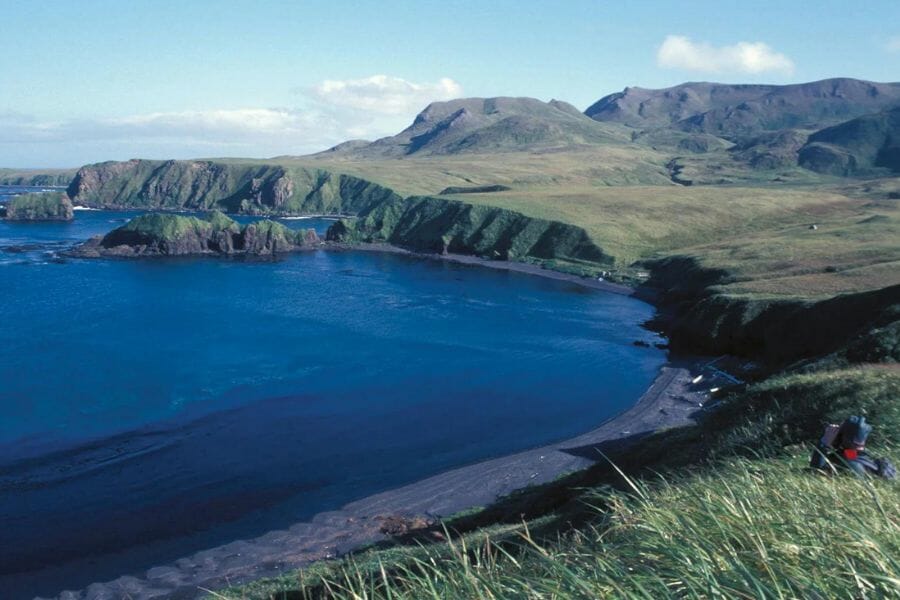
The Aleutian Islands in Alaska are a string of volcanic islands that stretch over 1,200 miles from the mainland. These islands are on the Pacific Ring of Fire and are prone to frequent volcanic eruptions and earthquakes. The terrain is rugged and dramatic, with cliffs, rocky shorelines, and towering peaks that rise to 10,000 feet above sea level.
The geography of the Aleutian Islands is unique because they serve as a bridge between two continents, North America and Asia. This has resulted in a diverse ecosystem home to marine life, including sea otters, whales, and sea lions. The islands are also a major stopover point for migratory birds. The climate of the Aleutians is typically cool and wet, with strong winds and frequent fog.
Where we found geode-like formations
- There are agates on the beach gravels of Sand Point in Shumagin Island.
- You can also find agates at the Captain’s Bay neighborhood to Priest Rock beach gravels in Unalaska Island.
DON'T MISS OUT ON ANY GREAT FINDS!
While you're out searching for Geodes you're going to find a lot of other interesting rocks and minerals along the way. The last thing you want to do is toss out something really interesting or valuable. It can be easy to misidentify things without a little guidance.
We've put together a fantastic field guide that makes identifying 140 of the most interesting and valuable rocks and minerals you will find REALLY EASY. It's simple to use, really durable, and will allow you to identify just about any rock and mineral you come across. Make sure you bring it along on your hunt!
Interior Region
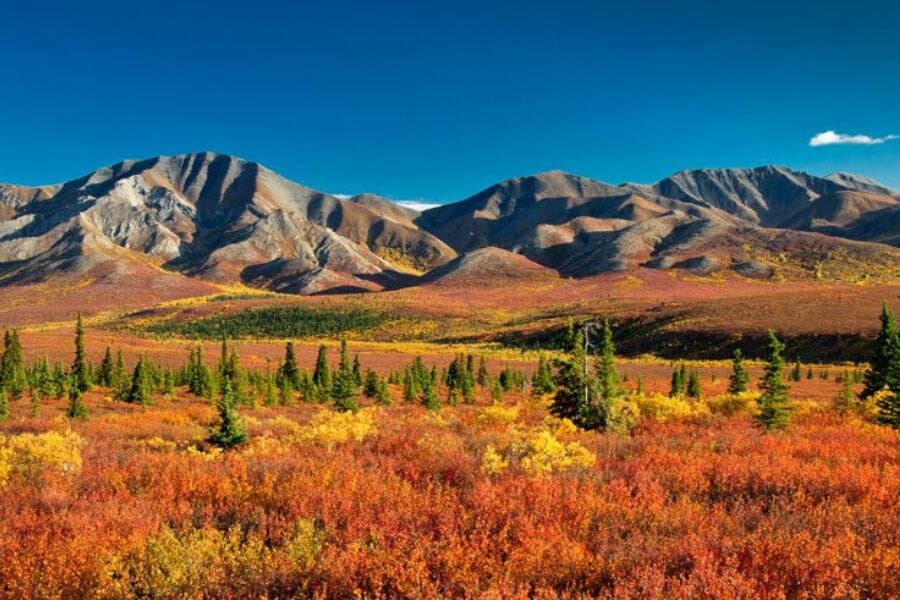
The Interior Region of Alaska is a vast, rugged wilderness, including forests, mountains, and glaciers. It’s the heart of Alaska and the perfect place for anyone looking to get off the beaten path and explore the great outdoors. The terrain is diverse, with rolling hills, steep mountains, and wide open plains. Aside from containing amazing geode-like formations, it’s also home to some of the best crystals in Alaska.
The geology of the Interior Region is also incredibly fascinating, with evidence of volcanic activity, earthquakes, and glaciation throughout the area. The region is home to several notable mountain ranges, including the Alaska Range, which includes Denali, the highest peak in North America. The Yukon River runs through the Interior, providing a lifeline for the communities that call this region home.
Where we found geode-like formations
- Quartz crystals are found at the local creek gravels in the district of Fairbanks.
- Amethyst with agate and quartz are abundant in the Healy area.
Ketchikan District
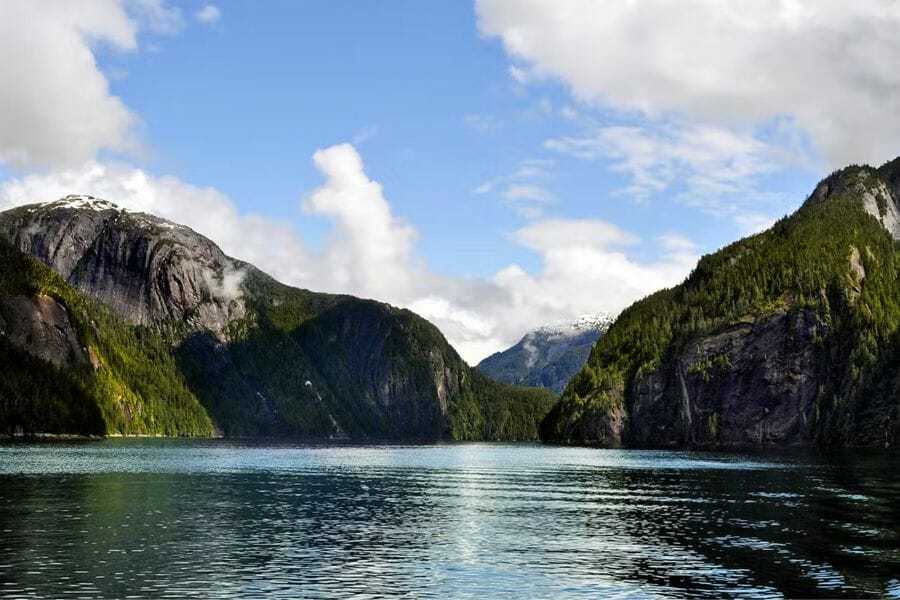
The Ketchikan District in Alaska is a stunningly beautiful area known for its rugged coastline, dense forests, and abundant wildlife. The district encompasses several islands, including Prince of Wales Island, the third-largest island in the United States. The terrain is characterized by steep mountains, deep fjords, and lush forests home to bears, eagles, and other wildlife.
The geology of the Ketchikan District is diverse and includes both volcanic and sedimentary rock formations. The area is also home to several glaciers, including the LeConte Glacier, one of the world’s fastest-moving glaciers. The district is a popular destination for outdoor enthusiasts.
Where we found geode-like formations
- The Green Monster Copper Mine at Sulzer contains quartz crystals.
Kobuk River Region
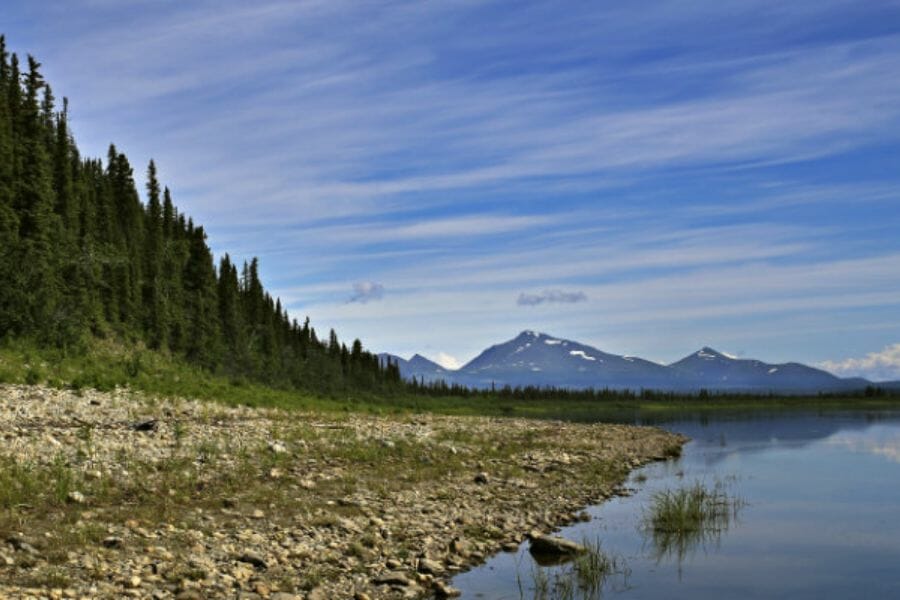
The Kobuk River Region in Alaska is a remote and pristine area home to some of the most stunning landscapes in the state. The region is located in the northwest part of Alaska, characterized by rugged mountains, vast tundra, and clear rivers. The Kobuk River is the main waterway in the region and offers excellent fishing and boating opportunities.
The geology of the Kobuk River Region is incredibly diverse, with evidence of volcanic activity, glaciation, and erosion throughout the area. The terrain is also home to several unique geological formations, including the Great Kobuk Sand Dunes, the largest active dunes in the Arctic. The region is also home to several important archaeological sites, including the Onion Portage site, which indigenous people have used for thousands of years.
Where we found geode-like formations
- The large area of the Kobuk River is widely known to have an abundance of quartz crystals.
Travel down south to Walker Valley Geode Location
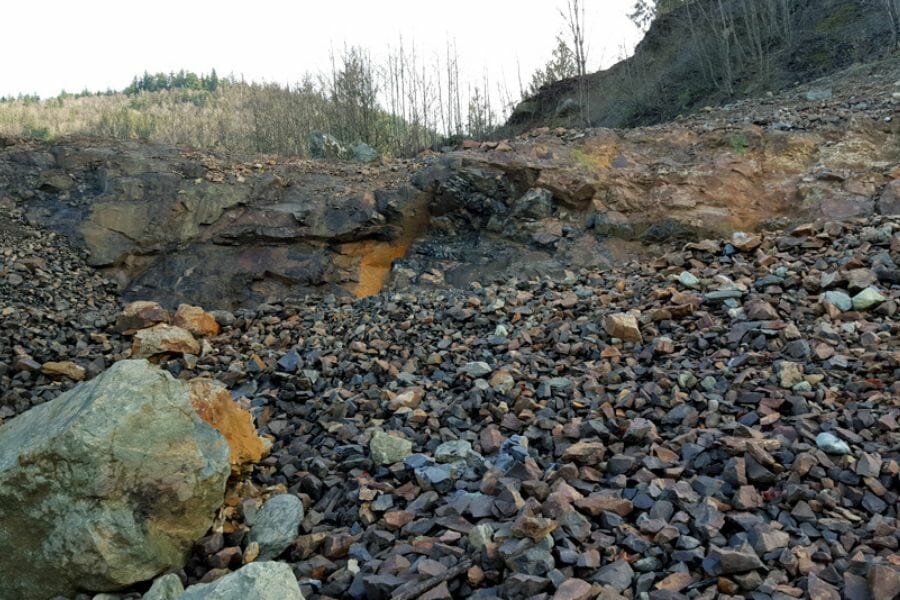
Visit Washington, the closest neighboring state of Alaska to the south, to locate more naturally occurring geodes. The Walker Valley is one of Washington’s best places to look for geodes.
The Walker Valley Geode Location in Washington is a popular destination for rockhounds and geology enthusiasts looking to find unique and stunning geodes. The location is in a rural area, about an hour north of Seattle, and is known for its diverse geology and beautiful terrain. The area is home to several types of geodes, including those filled with amethyst, calcite, and quartz.
The geology of the Walker Valley Geode Location is diverse, with evidence of volcanic activity and sedimentary deposits throughout the area. The terrain is characterized by rolling hills, rocky outcrops, and dense forests that make a beautiful backdrop to any geode-hunting excursion. The area is also home to several streams and rivers, which can be a great place to find geodes washed downstream.
Where we found geodes in Walker Valley
- Walker Valley Geodes is located in Skagit County, about 9 miles east of Mount Vernon, Washington. You can find amethyst geodes and quartz geodes here.
Common Alaska Geode-Hunting Questions
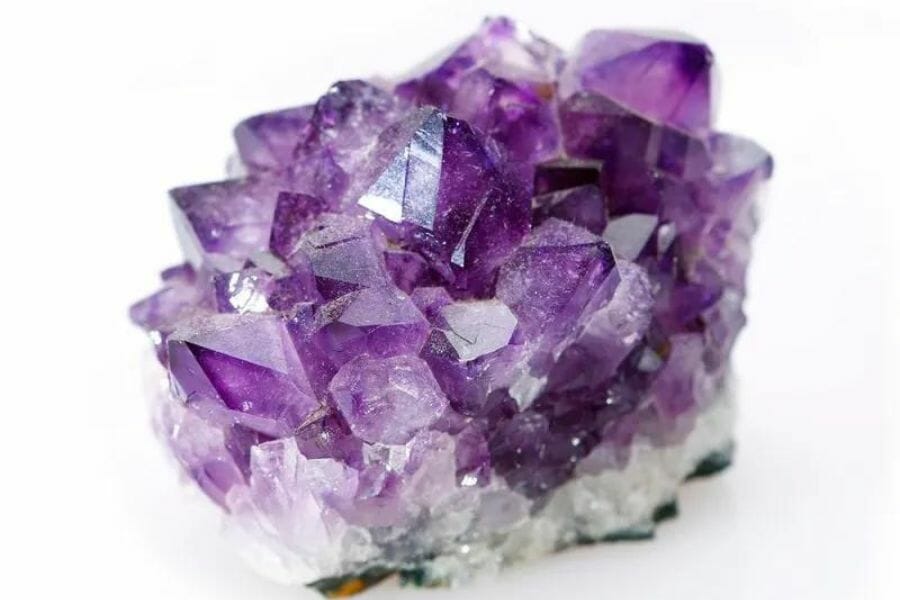
The following common questions concerning geode hunting are the ones we wanted to address in case you also have the same queries:
Where can you find amethyst geodes in Alaska?
Unfortunately, Alaska doesn’t have any naturally occurring amethyst geodes or crystals. Nevertheless, there are a few rock shops nearby where you might be able to discover them, as well as other gems. We’ve listed the shops below where you can locate them.
Is it illegal to collect geodes in Alaska?
In Alaska, acquiring and collecting geodes are both allowed if you abide by the applicable laws. Before planning your hunt, research any specific rules in public and private sites.
The Best Places To Buy Geodes In Alaska
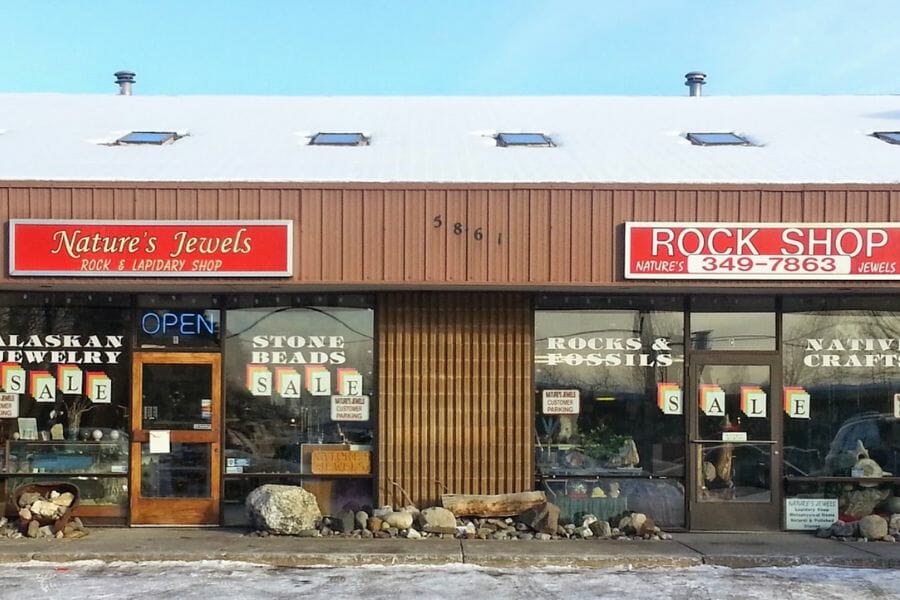
The most dependable way to bring one home in Alaska is to visit local rock shops selling geodes. Natural wonders like rocks and gems can also be found at many stores.
- Alaska Horn and Antler – 38778 Sterling Hwy, Soldotna, AK 99669, United States
- Amazon – You may purchase various geodes on Amazon. Whole kits are also available for individuals who want to crack it themselves.
- Nature’s Jewels Rock Shop – 5861 Arctic Blvd # B, Anchorage, AK 99518, United States
- PyeWackets – 39426B River Ridge Rd, Sterling, AK 99672, United States
- Salt | Pine – 165 E Bunnell Ave, Homer, AK 99603, United States
- Stars of Alaska – 2217 E Tudor Rd # 1, Anchorage, AK 99507, United States
Additional places to find geodes in nearby states
Check out our guides for nearby states if you’ve already tried all of our suggestions above or if you’re planning a trip outside of the state:
If you have any recommendations for our list, please comment below!

